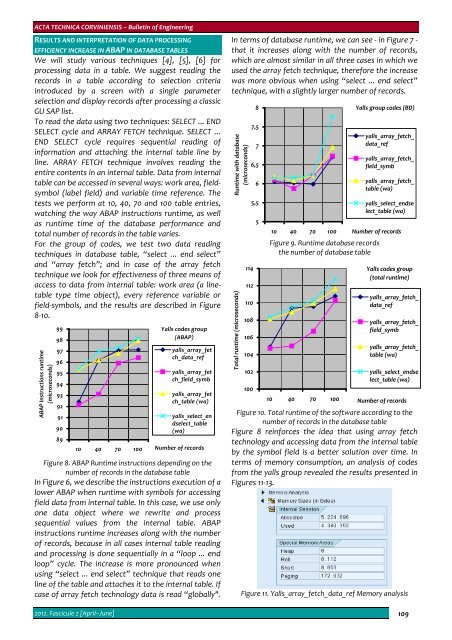Editorial & Advisory Board - Acta Technica Corviniensis
Editorial & Advisory Board - Acta Technica Corviniensis
Editorial & Advisory Board - Acta Technica Corviniensis
You also want an ePaper? Increase the reach of your titles
YUMPU automatically turns print PDFs into web optimized ePapers that Google loves.
ACTA TECHNICA CORVINIENSIS – Bulletin of Engineering<br />
RESULTS AND INTERPRETATION OF DATA PROCESSING<br />
EFFICIENCY INCREASE IN ABAP IN DATABASE TABLES<br />
We will study various techniques [4], [5], [6] for<br />
processing data in a table. We suggest reading the<br />
records in a table according to selection criteria<br />
introduced by a screen with a single parameter<br />
selection and display records after processing a classic<br />
GU SAP list.<br />
To read the data using two techniques: SELECT ... END<br />
SELECT cycle and ARRAY FETCH technique. SELECT ...<br />
END SELECT cycle requires sequential reading of<br />
information and attaching the internal table line by<br />
line. ARRAY FETCH technique involves reading the<br />
entire contents in an internal table. Data from internal<br />
table can be accessed in several ways: work area, fieldsymbol<br />
(label field) and variable time reference. The<br />
tests we perform at 10, 40, 70 and 100 table entries,<br />
watching the way ABAP instructions runtime, as well<br />
as runtime time of the database performance and<br />
total number of records in the table varies.<br />
For the group of codes, we test two data reading<br />
techniques in database table, “select ... end select”<br />
and “array fetch”; and in case of the array fetch<br />
technique we look for effectiveness of three means of<br />
access to data from internal table: work area (a linetable<br />
type time object), every reference variable or<br />
field‐symbols, and the results are described in Figure<br />
8‐10.<br />
ABAP Instructions runtime<br />
(microseconds)<br />
99<br />
98<br />
97<br />
96<br />
95<br />
94<br />
93<br />
92<br />
91<br />
90<br />
89<br />
Yalls codes group<br />
(ABAP)<br />
yalls_array_fet<br />
ch_data_ref<br />
yalls_array_fet<br />
ch_field_symb<br />
yalls_array_fet<br />
ch_table (wa)<br />
yalls_select_en<br />
dselect_table<br />
(wa)<br />
10 40 70 100 Number of records<br />
Figure 8. ABAP Runtime instructions depending on the<br />
number of records in the database table<br />
In Figure 6, we describe the instructions execution of a<br />
lower ABAP when runtime with symbols for accessing<br />
field data from internal table. In this case, we use only<br />
one data object where we rewrite and process<br />
sequential values from the internal table. ABAP<br />
instructions runtime increases along with the number<br />
of records, because in all cases internal table reading<br />
and processing is done sequentially in a “loop ... end<br />
loop” cycle. The increase is more pronounced when<br />
using “select ... end select” technique that reads one<br />
line of the table and attaches it to the internal table. If<br />
case of array fetch technology data is read “globally".<br />
In terms of database runtime, we can see ‐ in Figure 7 ‐<br />
that it increases along with the number of records,<br />
which are almost similar in all three cases in which we<br />
used the array fetch technique, therefore the increase<br />
was more obvious when using “select ... end select”<br />
technique, with a slightly larger number of records.<br />
Runtime with database<br />
(microseconds)<br />
Total runtime (microseconds)<br />
114<br />
112<br />
110<br />
108<br />
106<br />
104<br />
102<br />
100<br />
8<br />
7,5<br />
7<br />
6,5<br />
6<br />
5,5<br />
5<br />
Yalls group codes (BD)<br />
yalls_array_fetch_<br />
data_ref<br />
yalls_array_fetch_<br />
field_symb<br />
yalls_array_fetch_<br />
table (wa)<br />
yalls_select_endse<br />
lect_table (wa)<br />
10 40 70 100 Number of records<br />
Figure 9. Runtime database records<br />
the number of database table<br />
Yalls codes group<br />
(total runtime)<br />
yalls_array_fetch_<br />
data_ref<br />
yalls_array_fetch_<br />
field_symb<br />
yalls_array_fetch_<br />
table (wa)<br />
yalls_select_endse<br />
lect_table (wa)<br />
10 40 70 100 Number of records<br />
Figure 10. Total runtime of the software according to the<br />
number of records in the database table<br />
Figure 8 reinforces the idea that using array fetch<br />
technology and accessing data from the internal table<br />
by the symbol field is a better solution over time. In<br />
terms of memory consumption, an analysis of codes<br />
from the yalls group revealed the results presented in<br />
Figures 11‐13.<br />
Figure 11. Yalls_array_fetch_data_ref Memory analysis<br />
2012. Fascicule 2 [April–June] 109

















